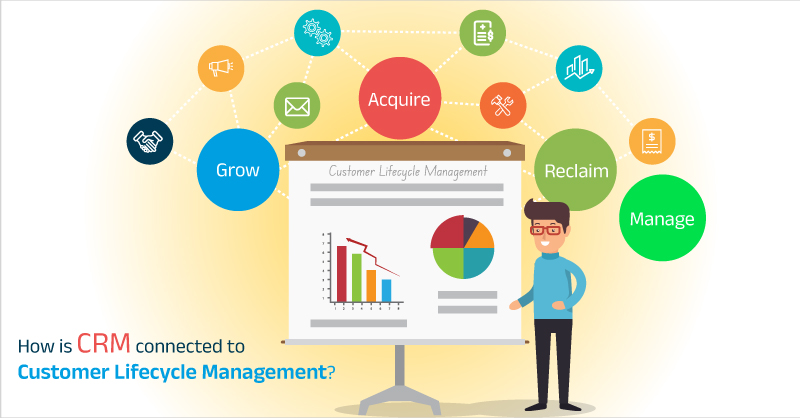Customer relationship management and customer lifecycle management (CLM) are two of the most important aspects of the B2B marketing space. While the former is nothing but a tool or software to help companies connect with existing customers in every stage of their life cycle, customer lifecycle management is the process of operating user journeys. CRM, sales force automation, and database marketing are three crucial segments that facilitate seamless management of the customer lifecycle at every stage.
Customer lifecycle management or CLM is a framework for managing a customer's relationship with a company. The goal of CLM is to provide an understanding, anticipate and respond to customer needs in order to increase sales opportunities by winning more business at each stage of the buyer's journey--from discovery through loyalty or attrition.
CLM is an approach to managing a customer's relationship with a company
The strategy for managing a customer's connection with a business is called customer lifecycle management (CLM). It offers a framework for comprehending, foreseeing, and meeting client wants.
It can be defined as: "The process of designing and implementing activities that enable interactions between customers and businesses over time," says the marketing experts.
CLM is built on empathy toward customer needs.
Customer lifecycle management (CLM) is an approach to managing a customer's relationship with a company. It involves understanding, anticipating, and responding to customers' needs throughout the entire life cycle of their relationship with your organization.
Relation of CRM and CLM
CRM helps organizations understand their customers in order to engage them at all stages of the customer lifecycle. This can be done by implementing predictive analytics that helps predict which customers will become loyal repeat buyers, as well as allowing you to know when they are likely to leave you for another brand or service provider.
Customer relationship management (CRM) is an emerging field that connects all aspects of the customer relationship - what they know about you, what they need from you, and how satisfied they are with your service.
It's important to remember that CRM isn't just about collecting data on customers or prospects; it also helps companies understand what their customers want in order to better engage them in a way that works for both parties involved.
When implemented correctly, CLM can help companies identify opportunities to engage existing customers and create new ones, as well as optimize their marketing reach and effectiveness.
This allows companies to optimize their marketing reach and effectiveness by finding out where their customers are located, what they like about your product or service, and how much money they spend with you.
The next step in the customer life cycle management process is personalization: using data from CRM systems to create individualized offers for each customer based on information such as demographics, interests, and behavior patterns. In addition, CRM software allows you to track purchase history so that you know which products have been purchased most frequently by each type of customer (aged vs young). This makes it easier for companies such as banks or insurance providers who sell financial services through various channels--such as websites or mobile apps--to provide tailored recommendations based on user preferences instead of relying solely on search engine rankings which could lead them down the wrong paths when trying to decide what kind of offer should be sent out the first time someone visits their site
Also Read - CRM Tracking: What is it and how to Execute it?
CRM makes it possible for companies to connect with existing customers in every stage of their user journey
CRM is a service that connects all aspects of the customer relationship. It helps companies identify opportunities to engage existing customers and create new ones, optimize their marketing reach and effectiveness, empower employees to provide excellent customer service, and more.
CRM can help you:
- Connect with your existing customers in every stage of their life cycle by identifying their needs, values, and preferences prior to making a purchase decision. Customer relationship management offers numerous tools to enhance understanding and interaction within customer journeys. For businesses specializing in niche markets such as specific vehicle shipping needs, CRM helps refine services to fit unique client requirements. For instance, integrating data insights can digitally optimize service offerings like fifth wheel transport, ensuring precision and personalized customer engagement throughout the transportation process.
- Leverage CRM data for personalized offers that are relevant to each individual.
- Use insights from past interactions with customers to improve future experiences.
Interrelation between CRM & CLM: In a Nutshell
Customer Relationship Management (CRM) and Contract Lifecycle Management (CLM) are two interrelated business processes that have a significant impact on the success of a business. Both CRM and CLM play a crucial role in improving the relationship between a business and its customers. While CRM focuses on managing interactions with customers throughout the customer lifecycle, CLM focuses on managing the entire lifecycle of a contract. This includes all CLM stages, from the point the contract is created to when signatures are collected, even aspects like contract renewal, approval, termination, and storage. The interrelation between CRM and CLM can bring numerous benefits to a business, including improved customer satisfaction, increased efficiency, and reduced risk.
CRM is a business strategy that aims to build and maintain long-term relationships with customers by collecting, storing, and analyzing customer data. CRM systems can track customer interactions across various touchpoints, including email, phone calls, and social media. This information can be used to gain insights into customer behavior and preferences, which can help businesses make informed decisions about marketing, sales, and service activities.
CLM, on the other hand, is a process that involves managing all aspects of a contract, from creation to renewal or expiration. CLM systems automate the contract management process, making it easier for businesses to keep track of contract details, such as expiration dates, renewal options, and pricing. CLM systems also provide visibility into contract performance and can help businesses identify and mitigate potential risks associated with contracts.
When integrated, CRM and CLM systems can provide businesses with a comprehensive view of their customer interactions and contracts. For example, a business can use CRM data to understand the needs and preferences of its customers and use that information to create contracts that better meet those needs. Additionally, the integration of CRM and CLM can help businesses avoid contract disputes by providing a clear and complete record of all customer interactions and contract details.
Wrapping up
When it comes to customer life cycle management, CRM is the foundation. It can help companies connect with existing customers in every stage of their life cycle.
Author Bio
Rahul believes empathy is the best way to create a delightful customer experience. With a keen eye for detail and data, Rahul is also a passionate CRM professional who's here to help you with your CRM-related queries



